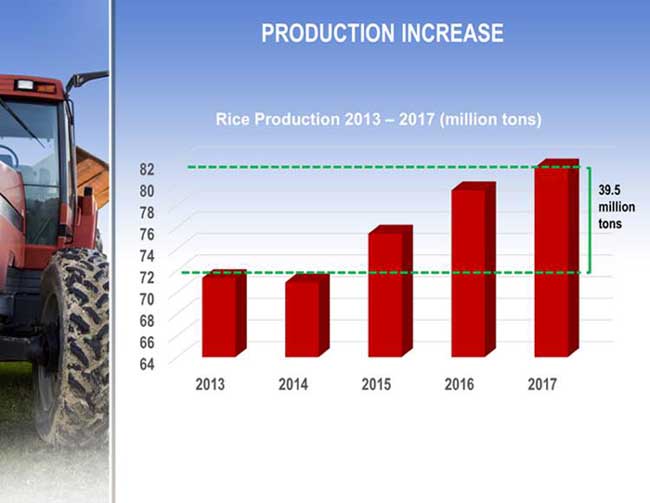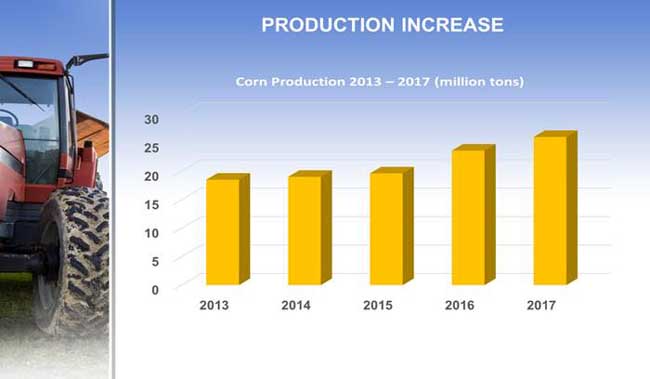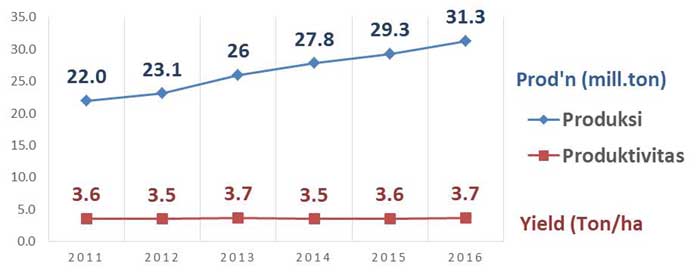Introduction
According to the Strategic Plan of the Ministry of Agriculture from 2015-2019, the primary focus of agricultural development is to achieve food sovereignity and farmers welfare. The corresponding strategic goals consist of: (a) to achieve self sufficiency on rice, corn, soybeans, and increase the production of beef and sugar; (b) increase food diversification; (c) increase value-added and competitiveness of certain commodities for export promotion and import substitution; (d) increase the availability of raw material for bioindustry and bioenergy; and (e) increase farmers’ welfare.
During 2015-2017 agriculture accounted for 10.1% to national GDP with an average growth of 3.3% per annum. Perennial crops accounted for the largest share to the GDP on agriculture (34.4%), followed by food crops (33.3%). Rice remains the largest strategic commodity which utilizes substantial public development resources. Rice also plays a major role on food security since 95% of the population depend on rice as a staple food.
The purpose of this brief is to present an overview of the major developments in agriculture up until 2017. We review major achievements on strategic commodities, particularly rice, corn, and oil palm. Major developments on government policy intervention is also presented.
Current progress
Rice production has increased significantly from 75.4 million tons in 2015 to 81.5 million tons in 2017, with an average growth of 3.95% during 2015-2017 (Fig. 1). Compared to the production level in 2013-2014 as a baseline, rice production in 2015-2017 was 10.98% higher. Successful efforts on increasing rice production has reduced the need for importing rice. Rice import has declined from 801,600 tons in 2015 to 127,200 tons in 2017. In 2016, rice import was recorded at 1. 3 million tons which include carry over contract from the earlier years. The impressive growth of rice production implies direct impact of the government policy on improving infrastructures, dissemination of improved technologies, subsidy on fertilizers and seeds, grants on agricultural machineries, and very tight supervision and monitoring involving agricultural officers in both central and regional offices.
The issue on the price of rice = is always subject to public attention because on the one hand, it signals incentive to the farmers but on the other hand, it influences the purchasing power of poor hauseholds and its contribution to the inflation rate. Based on the Regulation of the Minister of Agriculture (Permentan) No.03/2017, rice price at the farmgate was established at Rp. 4,600 (US$ 0.34) for unhusked paddy. On the other hand, to avoid accelerated rice price at the retail level, Regulation of the Minister of Trade No.57/2017 also determined the ceiling price at the retail level which varies according to the region around Rp.12,800-10,250 (US$ 0.70-0.76) for medium rice and Rp.12,800-13,600 (US$ 0.95-1.01). This policy has been debated widely because of the reduced margin of rice traders and rice millers.

Fig. 1. Trend of rice production, 2013-2017
As shown in Fig. 2, similar trend was also observed on corn production which increased from 19.6 million tons in 2015 to 26.0 million tons in 2017 (average growth of 15.3% during 2015-2017). Widespread dissemination on the use of hybrid corn along with strong corn demand for animal feeds are major drivers of accelerated corn production. Among the staple food crops, corn production is considered highly competitive and provides high return to the farmers.

Fig. 2. Trend of corn production, 2013-2017
With regard to export commodities, production of oil palms continues to show a strong growth which reached 31.3 million tons CPO in 2016, or an average annual growth of 6.1% in 2015-2016 (Fig. 3). The increase in production was primarily due to area expansion which reached 11.2 million ha in 2015 and 11.9 ha in 2016. Productivity of oil palms is almost stagnant at around 3.5-3.7 ton/ha. Private commercial farms expanded much faster (8.3%) compared to the smallholder farms (4.4%). In terms of enterprise structure, aproximately 54.6% of the total oil palm areas consist of private commercial farms. In 2016, the share of Indonesia to total world oil palm area and production was 55.5% and 48.3% respectively. Around 77% of oil palm production is exported which reached 24.2 million tons, equivalent to US$ 14.7 billion in 2016.

Fig. 3. Trend of oil palm production, 2011-2016[natalie1]
Policy development
Policy on promoting food security, in particular increase on staple food production continues to mark as major policy innitiatives. Special efforts to increase the production of rice, corn, and soybeans (UPSUS PAJALE in Bahasa Indonesia) involve agricultural officers from the central offices, provincial and municipal offices in all provinces of Indonesia. All officers have to report the incremental planted area of rice, corn, and soybeans in their designated region to the Ministry of Agriculture (MoA) on a weekly basis. This effort also involves military army to help facilitate local officers in supervising and monitoring farming practices and facilitate coordination across Ministries and work units within MoA. In the case of rice, farmers are obliged to sell their rice to the Regional office of BULOG (state owned enterprise in charge of rice marketing and price stabilization). There has been some concern on this “command” approach which destroys the already established system including local wisdom.
Fertilizer subsidy continues to be one of major support to agriculture, targeted primarily to food crops. In 2017, the value of fertilizer subsidy was Rp.31.2 trillion (US$ 2.31 billion) with the total volume of subsidized fertilizer approximately 1 million tons. The percentage of subsidy varies accross fertilizer types. Urea receives the highest subsidy, namely 67.2% of the market price.
To accelarate the use of mechanization, MoA also provides direct grant of agricultural machineries to the farmers group. In 2007, the machinery grant consisted of: two-wheel tractor 46,980 units, four wheel tractors 2,280 units, water pump 19,518 units, rice transplanter 7,854 units, combined harvester 9,564 units, power thresher 9,472 units, rice milling 15,300 units. There has been some concern on the sustainability of this grant, after the support is terminated.
Priority in 2018: Poverty alleviation
In accordance to national development priority, in 2018 the MoA addresses special focus on poverty alleviation in rural areas and agriculture. According to the Central Bureau of Statistic, in March 2018 it is estimated that number of population under poverty line is 25.95 million or 9.82% of total population. This estimate is the first single digit poverty rate ever reported in Indonesia’s development. However, poverty incidence in rural region is larger (13.2%) compared to urban poverty (7.02%). Many studies reported that poor people in rural region mostly work in agriculture. Therefore, an inclusive agricultural development plays an important role in alleviating poperty, particularly in rural regions.
The program of MoA is to improve the welfare of poor farmers which consist of: (a) grant of agricultural supplies which include seed/breed/planting material of horticulture crops, perennial crops, livestock, and agricultural equipments; (b) development of the sutainable food cluster; (c) empowerment of the poor household through cash for work program; and (d) strengthening investment and working capital.
Grant program targeted to the foor people consists of: ( a) tractor 15,000 units; (b) planting material of horticulture: chili 2.4 million units, rambutan 1.9 million units, mango 1.9 million units, and orange 1.9 million units; (c) planting material of perennial crops: coffee 9.5 million units, coconut 4.7 units, and nutmeg 4.7 million units; and (d) animal breed: doc[natalie2] /ducks 41.6 million heads, goat 80 thousand heads, and rabbit 150,000 heads.
Conclusion
Agricultural development has shown a remarkable performance, particularly in terms of staple rice and corn production. This achievement has been reached with substantial public support, particularly fertizer subsidy. The command approach is also subject to criticism because it destroyed current and established standard system and also local wisdom. In the comming new administration, it is necessary to carefully assess the performance and formulate a new strategy accordingly.
References
Ministry of Agriculture. 2016. Report of agricultural development in 2016. Ministry of Agriculture, Jakarta.
Minister of Agriculture. 2018. Briefing note on agricultural development policy in 2018. Ministry of Agriculture, Jakarta.
Date submitted: Aug. 9, 2018
Reviewed, edited and uploaded: Oct. 15, 2018 |


An Overview of Indonesia’s Agricultural Policies in 2018
Introduction
According to the Strategic Plan of the Ministry of Agriculture from 2015-2019, the primary focus of agricultural development is to achieve food sovereignity and farmers welfare. The corresponding strategic goals consist of: (a) to achieve self sufficiency on rice, corn, soybeans, and increase the production of beef and sugar; (b) increase food diversification; (c) increase value-added and competitiveness of certain commodities for export promotion and import substitution; (d) increase the availability of raw material for bioindustry and bioenergy; and (e) increase farmers’ welfare.
During 2015-2017 agriculture accounted for 10.1% to national GDP with an average growth of 3.3% per annum. Perennial crops accounted for the largest share to the GDP on agriculture (34.4%), followed by food crops (33.3%). Rice remains the largest strategic commodity which utilizes substantial public development resources. Rice also plays a major role on food security since 95% of the population depend on rice as a staple food.
The purpose of this brief is to present an overview of the major developments in agriculture up until 2017. We review major achievements on strategic commodities, particularly rice, corn, and oil palm. Major developments on government policy intervention is also presented.
Current progress
Rice production has increased significantly from 75.4 million tons in 2015 to 81.5 million tons in 2017, with an average growth of 3.95% during 2015-2017 (Fig. 1). Compared to the production level in 2013-2014 as a baseline, rice production in 2015-2017 was 10.98% higher. Successful efforts on increasing rice production has reduced the need for importing rice. Rice import has declined from 801,600 tons in 2015 to 127,200 tons in 2017. In 2016, rice import was recorded at 1. 3 million tons which include carry over contract from the earlier years. The impressive growth of rice production implies direct impact of the government policy on improving infrastructures, dissemination of improved technologies, subsidy on fertilizers and seeds, grants on agricultural machineries, and very tight supervision and monitoring involving agricultural officers in both central and regional offices.
The issue on the price of rice = is always subject to public attention because on the one hand, it signals incentive to the farmers but on the other hand, it influences the purchasing power of poor hauseholds and its contribution to the inflation rate. Based on the Regulation of the Minister of Agriculture (Permentan) No.03/2017, rice price at the farmgate was established at Rp. 4,600 (US$ 0.34) for unhusked paddy. On the other hand, to avoid accelerated rice price at the retail level, Regulation of the Minister of Trade No.57/2017 also determined the ceiling price at the retail level which varies according to the region around Rp.12,800-10,250 (US$ 0.70-0.76) for medium rice and Rp.12,800-13,600 (US$ 0.95-1.01). This policy has been debated widely because of the reduced margin of rice traders and rice millers.
Fig. 1. Trend of rice production, 2013-2017
As shown in Fig. 2, similar trend was also observed on corn production which increased from 19.6 million tons in 2015 to 26.0 million tons in 2017 (average growth of 15.3% during 2015-2017). Widespread dissemination on the use of hybrid corn along with strong corn demand for animal feeds are major drivers of accelerated corn production. Among the staple food crops, corn production is considered highly competitive and provides high return to the farmers.
Fig. 2. Trend of corn production, 2013-2017
With regard to export commodities, production of oil palms continues to show a strong growth which reached 31.3 million tons CPO in 2016, or an average annual growth of 6.1% in 2015-2016 (Fig. 3). The increase in production was primarily due to area expansion which reached 11.2 million ha in 2015 and 11.9 ha in 2016. Productivity of oil palms is almost stagnant at around 3.5-3.7 ton/ha. Private commercial farms expanded much faster (8.3%) compared to the smallholder farms (4.4%). In terms of enterprise structure, aproximately 54.6% of the total oil palm areas consist of private commercial farms. In 2016, the share of Indonesia to total world oil palm area and production was 55.5% and 48.3% respectively. Around 77% of oil palm production is exported which reached 24.2 million tons, equivalent to US$ 14.7 billion in 2016.
Fig. 3. Trend of oil palm production, 2011-2016[natalie1]
Policy development
Policy on promoting food security, in particular increase on staple food production continues to mark as major policy innitiatives. Special efforts to increase the production of rice, corn, and soybeans (UPSUS PAJALE in Bahasa Indonesia) involve agricultural officers from the central offices, provincial and municipal offices in all provinces of Indonesia. All officers have to report the incremental planted area of rice, corn, and soybeans in their designated region to the Ministry of Agriculture (MoA) on a weekly basis. This effort also involves military army to help facilitate local officers in supervising and monitoring farming practices and facilitate coordination across Ministries and work units within MoA. In the case of rice, farmers are obliged to sell their rice to the Regional office of BULOG (state owned enterprise in charge of rice marketing and price stabilization). There has been some concern on this “command” approach which destroys the already established system including local wisdom.
Fertilizer subsidy continues to be one of major support to agriculture, targeted primarily to food crops. In 2017, the value of fertilizer subsidy was Rp.31.2 trillion (US$ 2.31 billion) with the total volume of subsidized fertilizer approximately 1 million tons. The percentage of subsidy varies accross fertilizer types. Urea receives the highest subsidy, namely 67.2% of the market price.
To accelarate the use of mechanization, MoA also provides direct grant of agricultural machineries to the farmers group. In 2007, the machinery grant consisted of: two-wheel tractor 46,980 units, four wheel tractors 2,280 units, water pump 19,518 units, rice transplanter 7,854 units, combined harvester 9,564 units, power thresher 9,472 units, rice milling 15,300 units. There has been some concern on the sustainability of this grant, after the support is terminated.
Priority in 2018: Poverty alleviation
In accordance to national development priority, in 2018 the MoA addresses special focus on poverty alleviation in rural areas and agriculture. According to the Central Bureau of Statistic, in March 2018 it is estimated that number of population under poverty line is 25.95 million or 9.82% of total population. This estimate is the first single digit poverty rate ever reported in Indonesia’s development. However, poverty incidence in rural region is larger (13.2%) compared to urban poverty (7.02%). Many studies reported that poor people in rural region mostly work in agriculture. Therefore, an inclusive agricultural development plays an important role in alleviating poperty, particularly in rural regions.
The program of MoA is to improve the welfare of poor farmers which consist of: (a) grant of agricultural supplies which include seed/breed/planting material of horticulture crops, perennial crops, livestock, and agricultural equipments; (b) development of the sutainable food cluster; (c) empowerment of the poor household through cash for work program; and (d) strengthening investment and working capital.
Grant program targeted to the foor people consists of: ( a) tractor 15,000 units; (b) planting material of horticulture: chili 2.4 million units, rambutan 1.9 million units, mango 1.9 million units, and orange 1.9 million units; (c) planting material of perennial crops: coffee 9.5 million units, coconut 4.7 units, and nutmeg 4.7 million units; and (d) animal breed: doc[natalie2] /ducks 41.6 million heads, goat 80 thousand heads, and rabbit 150,000 heads.
Conclusion
Agricultural development has shown a remarkable performance, particularly in terms of staple rice and corn production. This achievement has been reached with substantial public support, particularly fertizer subsidy. The command approach is also subject to criticism because it destroyed current and established standard system and also local wisdom. In the comming new administration, it is necessary to carefully assess the performance and formulate a new strategy accordingly.
References
Ministry of Agriculture. 2016. Report of agricultural development in 2016. Ministry of Agriculture, Jakarta.
Minister of Agriculture. 2018. Briefing note on agricultural development policy in 2018. Ministry of Agriculture, Jakarta.
Reviewed, edited and uploaded: Oct. 15, 2018